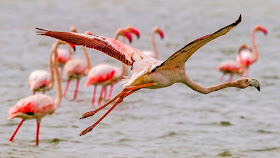Pulicat Lake Bird Sanctuary,
Thiruvallur
Pulicat Lake Bird Sanctuary is a famous
481 km² located in Nellore district of Andhra Pradesh and Protected
area in Thiruvallur
District of Tamil Nadu state
in South India. Pulicat Lake Bird Sanctuary is one of the most famous Bird Sanctuaries in India. This Sanctuary
is a haven for bird lovers and Ornithologists. Stretching across 481 square
kilometers, Pulicat is the second largest brackish water ecosystem in India
after lake Chilika of Orissa.
Pulicat is an extremely sensitive area
environmentally and is under threat of disappearing due to excessive siltation.
Environmentalists are currently in the process of getting Pulicat declared as a
site under the Ramsar Convention. The atmosphere at this Sanctuary defines
tranquility. International name: Pulicat Lake Wildlife Sanctuary, IBA Code: IN261, Criteria:
A1, A4iii.
The Arani River at the southern tip, the Kalangi
River from the northwest, the Swarnamukhi River at the northern end and the
Buckingham canal brings in the city’s drainage water feed this water lagoon. The
Pulicat sanctuary is drained by Arni River while the Buckingham canal brings in
the city’s drainage water. At the southern end is an opening on to Bay of
Bengal through a shallow mouth of 200 m in width. The rest of the lake is
closed by a sand bar running parallel to the Bay of Bengal in the form of the
Sriharikota Island.
Geography
The sanctuary lies exactly within 11°30’N to 11°42’N
and 76°30’E to 76°45’E. 327.33 km² is managed by the Andhra
Pradesh Forest Department and 153.67 km² is managed by the Tamil Nadu
Forest Department.
108 km² is National Park area. The average rainfall of this region ranges
between 800 and 2000 mm. The temperature of this sanctuary lies between 14°C
and 33°C. The altitude of this sanctuary ranges between 100’ MSL and 1200’ MSL.
There is greatest threat to this region as there is a chance for this lake to
disappear in next 100 years because of silt formation. Both private
Non-government organization and Indian government are doing their best to halt
the destruction of this lake.
Pulicat
Lake
For
brief details, please refer below link;
Flora
& Fauna
The lagoon which is about a million years old
separated from Bay of Bengal by a spit of land. During the monsoon period, the lake
is filled by nutritious water and large numbers microscopic plant grows
abundantly in the lake which provide food for invertebrates and fish. As a
result, large amount of wetland birds is attracted to the lake. But nowadays,
the lake faces many environmental issues such as over-fishing, agricultural
chemicals etc. Due to this, GNF (Global Nature Fund) nominates Lake Pulicat as
'Threatened Lake of the Year 2010'.
The sanctuary is most noted for the many greater flamingos seen here. The biodiversity of this lake
attracts hundreds of thousands of visitors per year. The lagoon is an important
habitat for 160 species of fish, 25 species of polychaetes worms, 12 species of
prawn, 19 species of mollusk, 100 species of birds both terrestrial and aquatic
birds and small mammals and reptiles. Migratory birds mainly from Central Asia
and Eastern Europe, visits this sanctuary.
The sanctuary mainly attracts Greater and Lesser
Flamingoes, Grey Pelican, Painted Stork, Grey Heron, Ducks, Marbled teal,
Terns, Egrets, Kites and Partridges, Quails, Sea Gulls and a number of Waders
such as curlews, stilts, plovers, sand pipers, lapwings and redshank. During
the winter season, the sanctuary attracts up to 15,000 flamingoes. Some of the
commonest wetland birds include Shoveler, Garganey, Gadwall, Marsh Sandpiper
and Black-tailed Godvit.
Some of the resident birds listed are Grey Pelican
and Open-billed Stork. The lake is also home to crabs, clams, mussels, oysters,
snails, fish worms, insects, spiders, sponges, anemone, prawns, plankton and so
on. The sanctuary provides eco-tourism on this lake by traditional punting or
sailing in a flat-bottom boat rather than by a motorized boat.
Activities
The Sanctuary offers activities such as trekking
through the exotic forestation, Bird safari and bird watching, Aquatic sports,
etc. The Sanctuary supports eco-tourism on the lake by allowing traditional
punting or sailing in a flat-bottom boat and not by a motorized boat. Bird
watching in the Sanctuary is an enriching experience especially just before the
sunsets when the birds fly away to perch, to observe their varied hues against
the evening sky is the epitome of nature’s beauty.
Best Time
to Visit
The best time to visit Pulicat Lake Bird Sanctuary is between October to March.
The temperature is mild and pleasant and makes travelling to the area easy.
This is also the best time to observe the migratory birds and especially the
flamingos. Seeing the Flamingos in the wetland is a once in a lifetime
experience. There are forest rest houses available in the form of 2 suites for
accommodation.
Facts
1.
Entry Fee: Regular Ferry across the
Lake, to the Lighthouse – Rs 2.00 per person.
2.
Entry Fee: Exclusive boat for the
day – Rs 400/- per day.
3.
Timings: 6:00 AM – 6:00 PM
4.
Accommodation: Forest Rest House with 2
suites available for stay or can stay either at Chennai / Thirupathi /
Sullurpeta.
Contact
Wildlife Warden,
259 Anna Salai, DMS compound, 3rd
Floor
Teynampet, Chennai 600 006
Phone: +91 44 2432 1139
Connectivity
The
Sanctuary is located at about 500 meters from Pazhaverkadu Bus Stop, 1.5 Kms
from Pulicat Bus Stand, 9 Kms from Thirupalaivanam, 10 Kms from Karungali, 20
Kms from Ponneri, 20 Kms from Ponneri Railway Station, 74 Kms from Thiruvallur,
70 Kms from Chennai Airport and 55 Kms from Chennai. Town buses are frequently available
from Ponneri and Red Hills.















